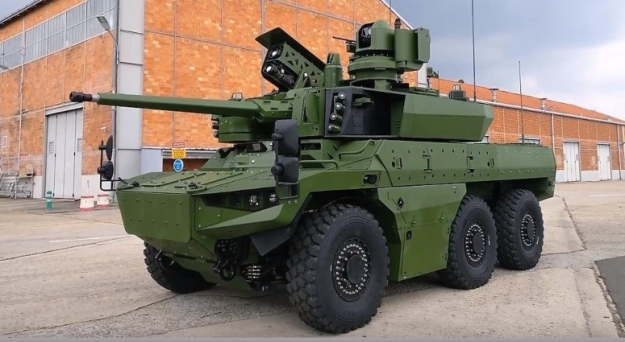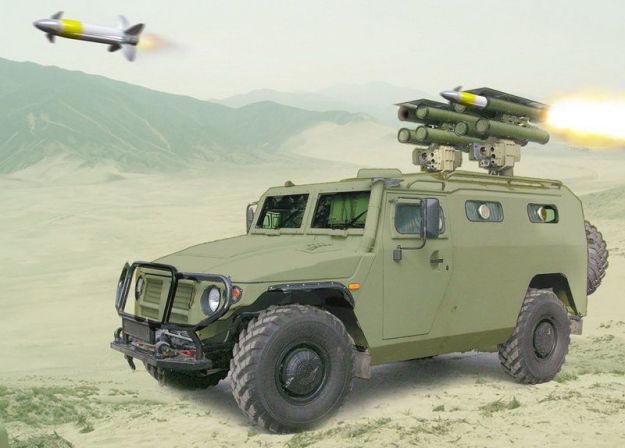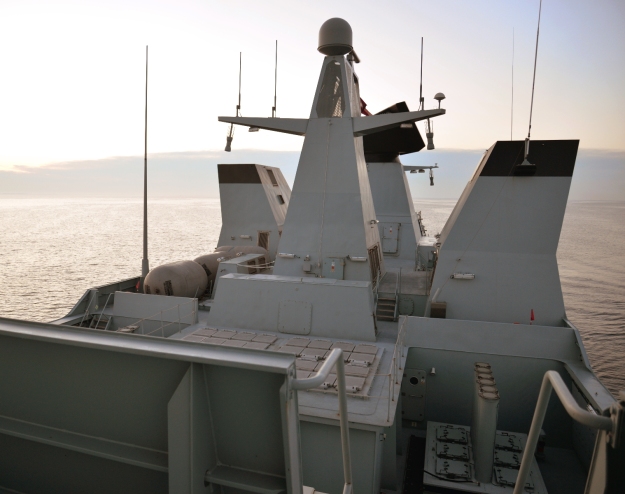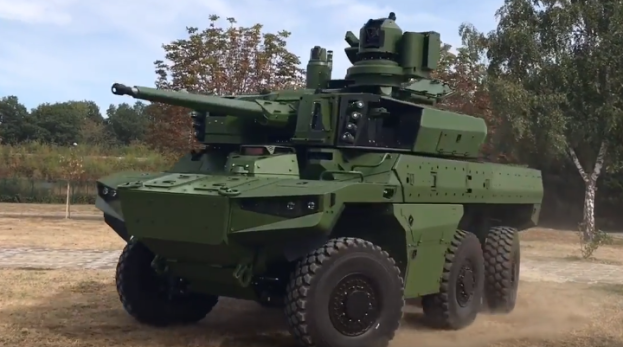The Jaguar 6×6 armoured reconnaissance and combat vehicle (EBRC) is being developed by a consortium of Nexter Systems, Thales, and Renault Trucks Defense, primarily for the French Army.
A total of 248 Jaguar EBRC units are planned for acquisition by the French Defense Procurement Agency (DGA) through its Scorpion multi-role armoured vehicle programme, which will aid the French Army in meeting its mission requirements on the modern battlefield.
The new-generation vehicles are intended to replace the French Army’s ageing fleet of AMX10RC 6×6 light reconnaissance vehicles and ERC Sagaie 6×6 armoured vehicles, as well as the VAB (véhicule de l’avant blindé) HOT armoured fighting vehicles.
The Jaguar vehicle offers high protection, increased mobility, and enhanced firepower for land-based forces.

Jaguar EBRC orders and deliveries
French companies Nexter Systems, Thales, and Renault Trucks Defense established a consortium in January 2014 for the collaborative development of two types of armoured vehicle solutions for the Scorpion programme, which covers the Jaguar EBRC and Griffon multi-role armoured vehicle (VBMR).
The French DGA awarded a contract to the three-member consortium in December 2014 to design, develop and manufacture the Jaguar vehicle. The deal also covers armament and logistics support for the vehicles during the qualification and manufacturing phases.
France’s DGA awarded a contract to the consortium to manufacture and deliver 20 Jaguar armoured vehicles in April 2017.
The vehicles are currently expected to be delivered to the French Army by 2020.
Jaguar EBRC design details
 techtronics
techtronics
The Jaguar armoured reconnaissance and combat vehicle is based on all-terrain six-wheeled chassis.
 Shephard Media
Shephard Media
It features a gross weight of 25t and can carry a crew of up to three members.
 Shephard Media
Shephard Media
The crew stations are placed in a fully enclosed armoured crew compartment, which is equipped with air-conditioning and internal overpressure systems.
 Emergency escape hatch – Forcesoperations
Emergency escape hatch – Forcesoperations
Weaponry of Jaguar armoured vehicle
ACTA International 40mm Cased Telescoped Armament System (CTAS) is the main armament of the Jaguar EBRC.
The 40mm cannon unit is mounted on a remote-control weapon system, and is able to defeat light armoured, urban, and soft targets at a rate of fire of 200 rounds a minute.
40mm Cased Telescoped Armament System (CTAS)

The 40 CTAS has been conceived as the next generation weapon of choice for medium calibre systems within Armoured Fighting Vehicles and Infantry Fighting Vehicles. The novel rotating breach technology and the associated cased telescope ammunition of the 40 CTAS is such that it is easily integrated within both manned and unmanned turrets with the benefit of minimum intrusion within the turret. The benefits are multiple in that the crew has greater space within which to operate, the unmanned turret has more space for additional equipments or better stealth profile, the vehicle having a more powerful weapon at its disposal than those with similar calibre equivalents. The 40 CTAS has been designed to provide a future proof capability against armoured threats, urban targets and soft targets in all combat theatres.

– 40 mm Cased Telescope Armament System
– Novel rotating breach mechanism,
– Up to 200 rounds per minute rate of fire, single shot, burst and continuous
– Ability to fire over a wide range of elevation (-10° to +75°)
– Ammunition Natures (GPR-AB-T, GPR-PD-T, APFSDS-T, TP-T and TPRR-T)
Status: CTAI is currently under contract with the UK MoD and French DGA to qualify the 40 CTAS Cannon and Ammunition in readiness for use on the UK MoD WCSP and FRES-SV programmes and for the French DGA for the future EBRC programme. Source nexter-group.fr
 Shephard Media
Shephard Media
The range of munitions developed for the 40 CTAS has been conceived to provide the operators of medium calibre systems within Armoured Fighting Vehicles and Infantry Fighting Vehicles a wide range of capabilities with levels of performance above that from weapons of a similar calibre.
The currently available ammunition types are:
– General Purpose – Air Burst – Tracer (GPR-AB-T) to neutralize dismounted infantry,
– GPR – Point Detonation – Tracer (GPS-PD-T) to defeat reinforced concrete walls with delay fuze,
– Armour Piercing Fin Stabilised Discarding Sabot – Tracer (APFSDS-T) able to penetrate 140mm of RHA (frontal arc of some first generation MBT and all IFV’s),
– Target Practice – Tracer (TP-T) and TP Reduced Range – Tracer (TPRR-T).

40 mm Cased Telescope Armament System Ammunition
– Munition projectile “Cased” and surrounded by propellant,
– High muzzle exit velocity across the range of munitions,
– High levels of precision,
– Cylindrical shape allowing ease of handling for automatic loading into weapon and reloading by the operator within the turret.
Status: CTAI is currently under contract with the UK MoD and French DGA to qualify the 40 CTAS Cannon and Ammunition in readiness for use on the UK MoD WCSP and FRES-SV programmes and for the French DGA for the future EBRC programme. Source nexter-group.fr
“In terms of firepower, French will replace the high caliber weapons such as the 90mm and 105mm with the new 40mm CT medium caliber cannon in the reconnaissance role.
I think this will give them, rapid firing capability supported by a new generation sighting system for the gunner and commander plus a modern fire-control system that will satisfy a high first round hit probability.
Coupled with the 40mm ammunition’s acclaimed high penetration and the capabilities coming from the use of programmable rounds, Jaguar will have a quite good lethality against a large range of targets.
The modern sighting equipment and data communication capability will also have an impact on the performance and success of the reconnaissance missions.
The UK’s Scout SV a 40+ ton tracked vehicle with 40mm CT two-men turret and France’s 6×6 25 ton wheeled vehicle with a similar weapon system show two different approaches in armored reconnaissance and only time will tell how they will perform.” Source warfare757.rssing.com
The vehicle is also armed with MBDA’s man-portable medium-range missile (Missile Moyenne Portée), which is effective against both static and moving targets.
It offers superior fire power against a variety of targets, including infantry vehicles and heavily armoured vehicles.
Missile Moyenne Portée

MMP is the latest (fifth) generation land combat missile system designed for dismounted infantry as well as for integration on combat vehicles.
Featuring both fire-and-forget and man-in-the-loop operation, network-enabled MMP also receives third party target designation for indirect firing scenarios.
MMP’s design includes the growth potential necessary for a future family of missiles for modern land combat.
 Shephard Media
Shephard Media
MMP will replace the Milan and Javelin anti-tank missiles in service with the French Army and special forces from 2017. Taking into account the battle experience gained from recent conflicts in which the French Army has been engaged, MMP is a response to the demands that have been expressed in terms of required capabilities: firing from confined spaces, “fire-and-forget”, and self-guidance with a “man-in-the-loop” facility.
- Lightweight weapon system, easily man-portable
- High level of day and night, all-weather reconnaissance and identification capability
- Confined space firing capability
 mage: janes.com
mage: janes.com
- Weight (incl. Tube) : 15 kg
- Length : 1.3 m in tactical canister
- Diameter : 140 mm
- Range : 4.000 m
Source mbda-systems.com
A 7.62mm machine gun can be fitted to further increase the vehicle’s firepower capabilities.
7.62mm machine gun (FN) T3 RCWS
 Armée de Terre
Armée de Terre
| CALIBER |
OPERATING PRINCIPLE |
WEAPON LENGTH |
BARREL LENGTH |
FEEDING |
WEIGHT |
CYCLIC RATE OF FIRE |
| 7.62x51mm NATO |
Gas operated, open breech |
1.260mm (49.60″) |
Rifled portion: 487.5mm (19.19″)
Overall: 630mm (24.80″) |
Belt |
Weapon: ~ 11.8 kg (26.01 lb)
Barrel assembly: ~ 3.050 kg (6.75 lb) |
650 to 1,000 RPM |
Source fnherstal.com
Jaguar vehicle protection features
The French Army’s new-generation armoured fighting vehicle is designed to offer high levels of NATO STANAG-standard protection against small arms fire, projectiles, bullets and weapons.
It also incorporates nuclear, biological and chemical (NBC) and mine protection kits for defence against improvised explosive devices (IED) and mine blasts.
Self-protection for the vehicle’s crew is provided by four smoke-grenade launchers, which are located on either side of the turret.
Galix grenade launchers
 Galix grenade launchers on both sides of the turret – Armée de Terre
Galix grenade launchers on both sides of the turret – Armée de Terre
The system detects the position of the threat and transfers this data to the fire control systems of the infantry fighting vehicles and main battle tanks.
The Galix suite is not only for the purpose of self-defence (passive action) but also to actively neutralize hostile personnel.
Lacroix offers combat proven solutions which are unique and global in scope. Land passive defence systems manufactured by Lacroix have been installed on more than 5,000 military vehicles.
The Galix 360 degree automatic obscuration system protects armored vehicles against all types of guided missiles.
 Galix grenade launchers at the rear – Shephard Media
Galix grenade launchers at the rear – Shephard Media
– Manual / stand alone system : 6 or 8 launch tubes
– Automatic System : up to 12 launch tubes
– Automatic / connected system, distributed architecture : up to 24 launch tubes
Source lacroix-defense.com
Thales’ Antares

Thales describes Antares as a “real-time day and night local awareness and softkill” for combat vehicles. The single payload provides 360° situation awareness and features an integrated laser warning system capable of providing self-protection against close-in threats; rear view and driving aids; and an external view for mounted soldiers ahead of egress from the vehicle. The laser warning system is capable of detecting laser range finders operating at 1.54 nm and 1.06 nm with threat localisation of less than 2°. An optional acoustic gunshot detection system is being considered for integration in the future. Source janes.com
 Antares – Armée de Terre
Antares – Armée de Terre
Metravib Pilar V acoustic sensor

PILAR vehicle version is designed for the protection of heavy and light armoured vehicles, as well as police armoured vehicles. It is available as a tetrahedral acoustic array mounted on the vehicle roof. It can also include a display indicating the shot origin and identification.
Real time threat monitoring
- Provides GPS coordinates and identification of the threats
- Good accuracy for determining the shot origin:
- Azimuth: ±2°
- Elevation: ±3°
- Range: ±10%
- Operating during fighting attacks with multiple threats such as Small Arm Fires, RPGs and Mortars.

Source metravib-defence.com
Observation and fire control
 sturgeonshouse.ipbhost.com
sturgeonshouse.ipbhost.com
The driver’s field of view is provided from a closed hatch via panoramic vision blocks.
Safran was selected to develop an optronics solution for the Jaguar EBRC based on the Paseo sighting system.
 Driver hatch – arronlee33
Driver hatch – arronlee33
The optronics system allows for detection, identification and tracking of land-based targets both during the day and at night.
Paseo sighting system
 PASEO for gunner – Shephard Media
PASEO for gunner – Shephard Media
Relying on its unique expertise in inertial and infrared technologies, Safran Electronics & Defense designed PASEO, the latest-generation of advanced panoramic sight to improve the survivability and fighting capabilities of the Infantry Fighting Vehicles (IFV) and Main Battle Tanks (MBT). Highly versatile, PASEO is perfectly suited to 30-125 mm Gunner and Commander’s applications as well as Forward Observation Artillery. Effective day and night, it provides a true “fire-on-the-move” capability, with a high firstround hit probability, whether on static or moving targets. Source safran-electronics-defense.com
 Gunner station left
Gunner station left
The gunner is seated on the left, he is also equipped with a direct optical channel, on the left, and with a Safran E/O viewer, on the right, aligned with the gun. Close situational awareness is provided by Thales’ Antares, which also doubles as a laser warning receiver, two being mounted, one front right and one rear left, to provide all-round coverage. A Metravib Pilar V acoustic sensor is also installed. Thales also provides the entire vetronic architecture of the Jaguar. Source edrmagazine.eu
 PASEO for commander – Shephard Media
PASEO for commander – Shephard Media
The commander observation systems are located on the right side of the turret, can use an all-optic panoramic sight located at the centre of the turret, as well as Safran’s dedicated Paseo electro-optic all-digital panoramic sight fitted on the remotely controlled weapon station. His hatch s fitted with episcopes allowing a 360° view. Source edrmagazine.eu
 Commander station
Commander station
SAVAN 11 Fire Control System

The SAVAN 11 Fire Control System is suited to high-performance IFVs and AFVs either as first-mount equipment or a mid-life up grade.
It provides a high first-round hit probability in all combat conditions.
Key features:
• Compact and modular
• Excellent performance-to-cost ratio, ideal for medium caliber turrets, whether manned or unmanned
• True fire-on-the-move capability
• Integrated fire-control computer for direct or indirect firing with coordinates
• High-performance stabilization, allowing single-shot or burst firing with the same high firstround hit probability
• Long-range target identification, making the SAVAN 11 ideal for asymmetrical or symmetrical operations
• Ready for NCW.
SAVAN 11 is composed of 2 main assemblies:
• The LST 11 gunner optronic sight
• The LJ 11 gunner day sight
(manned turret version only)
Source angelopodesta.com
 SAVAN 11 for gunner – Tim Fish
SAVAN 11 for gunner – Tim Fish
Command and control for the Jaguar armoured vehicle is provided by the onboard Scorpion forward information system (SICS), which has been equipped with a Bull battle management capability.
The system enables the transmission and sharing of information through a Thales Contact software-defined radio device.
Thales is in charge of the vetronics subsystem, and will develop and manufacture the SCORPION common vetronics solution, communication solutions, including the intercom system, perimeter vision system, self-protection suite and navigation system for all variants of the EBMR. In addition, Thales is responsible for the sensor payload for the VOA artillery observation vehicle (Véhicule d’Observation de l’Artillerie), which comprises a day/night sight with a laser target designator mounted on a telescopic mast and coupled to a GO12 radar. The vetronics network is designed to support the future Contact software-defined radio system, the SCORPION forward information system (SICS) and the Atlas artillery system, developed under separate contracts. The network also supports broader platform digitisation and network-centric operations. Source thalesgroup.com
Navigation and communications onboard Jaguar armoured vehicle
Thales is responsible to develop and supply navigation and communication for the Jaguar armoured vehicle, with integrated systems such as vetronics, an intercom unit and self-protection suite, as well as perimeter vision and navigation systems.
The vetronics system allows for internal data transfer and video management and provides support for the SICS and contact radio device.
The Jaguar EBRC comes with a number of countermeasures, including laser warning system, missile detection system, barrage jamming, and acoustic sniper localisation system.
As for communications, the vehicle will be equipped with one Thales Contact radio, allowing simultaneous data and voice communications in VHF and UHF bands, and with two PR4G radios. Source edrmagazine.eu
Thales Contact radio
ion of communication architecture standards and on the European waveform developed by the ESSOR partners to guarantee interoperability. Software radios and waveforms developed within this framework will meet new requirements with high operational value as armed forces transition to the digitised battlespace and increase their reliance on C4I, video transmissions and other value-added services during multinational operations.
Future CONTACT radio products will be fielded with the French Army, Air Force and Navy, providing faster transmission speeds, better security and heightened interoperability. They will be interoperable with the communication systems of other nations to support coalition operations.
These products will be interoperable with the PR4G waveform, thus assuring upward interoperability with PR4G radio equipment currently in service. Source: thalesgroup.com
PR4G radio

TRC 9310 B/C (2 radios) ?

TRC 9310 B/C (2 radios) PR4G F@stnet – VHF Vehicular Dual Fit Station
- Dual fit solutions: Relay (B version) – 2×50 W (C version)
- Dimensions (WxHxD): 400x195x320 mm
- Operating in proximity with several radios thanks to high performance co-site filter
- Dismountable for manpack use
Source thalesgroup.com
number of countermeasures, including laser warning system, missile detection system, barrage jamming, and acoustic sniper localisation system.
Engine and mobility
The Jaguar reconnaissance and combat vehicle is powered by a single diesel engine located in the front portion, delivering increased mobility across all terrain conditions.

On road the Jaguar uses the four rear wheels, the 6×6 traction being used only when going cross country, differentials being blocked progressively, depending on terrain conditions. The suspensions, provided by Quiri, allow to change the ground clearance depending on situations, lower on roads and higher in cross country, suspensions stiffness also changing depending on the height. An extra-low position allowing to better hide the vehicle when observing; it is also used for maintenance, to ease access to some elements, and when the vehicle is transported by rail. To reduce the turning radius both the first and third axle are steerable.
The Jaguar is fitted with the same pneumatics adopted on the Griffon, and is equipped with CTIS and run-flat systems. The front and rear axles are identical to those of the Griffon, which increases commonality, each axle being able to carry 9 tons. The Jaguar has a range of 800 km thanks to its 465 litres fuel tank; the one in the prototype is provisional, the final design foreseeing tne fuel tank heavily protected and one less protected but of the self-sealing type. Source edrmagazine.eu
 sturgeonshouse.ipbhost.com
sturgeonshouse.ipbhost.com
DXi 13-liter engine?

The 6×6 chassis was developed by RTD and is fitted with a Volvo engine providing 500 hp, coupled to the same ZF automatic six-speed transmission used in the Griffon 6×6 APC. It is to note that the reverse movement is obtained through an inverter and not through the transmission, which provides a much higher reverse speed. To reduce the vehicle’s length the engine and transmission, located at the back, are not mounted in sequence but in a ”U” configuration, through a horizontal transfer box. Source edrmagazine.eu

Source fandjexports.com

Specification military-today.com
Main material source army-technology.com
Materials from edrmagazine.eu
Images are form public domain unless otherwise stated
Main image by Olivier Berger
Revised Nov 04, 2018

 Russian MoD
Russian MoD

 Thermal sight 1PN80
Thermal sight 1PN80
 BMD-3 with Berezhok weapon system turret. The system contains: 30-mm 2A42 gun, 30-mm grenade launcher AG-30, 4 ATGM Kornet-E, 7.62 machine gun
BMD-3 with Berezhok weapon system turret. The system contains: 30-mm 2A42 gun, 30-mm grenade launcher AG-30, 4 ATGM Kornet-E, 7.62 machine gun
 BMD-2 with parts of Berezhok weapon system. The turret is from BMD-2, but additional modules from Berezhok system were used for the upgrade. In this modernization variant KBP design bureau used 2 ATGMs Kornet-E and combined gunner sight
BMD-2 with parts of Berezhok weapon system. The turret is from BMD-2, but additional modules from Berezhok system were used for the upgrade. In this modernization variant KBP design bureau used 2 ATGMs Kornet-E and combined gunner sight






 Peter Willemoes (F362)
Peter Willemoes (F362)


 Bridge
Bridge 


 Lockheed Martin mk41 multimissile vertical launch system (VLS) for the evolved Sea Sparrow missile (ESSM) and SM-2 IIIA missile
Lockheed Martin mk41 multimissile vertical launch system (VLS) for the evolved Sea Sparrow missile (ESSM) and SM-2 IIIA missile



 The Harpoon is an all weather, subsonic, over the horizon, anti-ship missile which can be launch from surface ships, submarines and aircraft. The Harpoon Block II is the latest version of the Harpoon missile and is able to strike land-based targets and ships in littoral environments. The Block II incorporated the GPS/INS guidance system of the JDAM bombs and the mission computer, software, and GPS antenna employed by the SLAM ER missile.
The Harpoon is an all weather, subsonic, over the horizon, anti-ship missile which can be launch from surface ships, submarines and aircraft. The Harpoon Block II is the latest version of the Harpoon missile and is able to strike land-based targets and ships in littoral environments. The Block II incorporated the GPS/INS guidance system of the JDAM bombs and the mission computer, software, and GPS antenna employed by the SLAM ER missile.

 The MU90/IMPACT Advanced Lightweight Torpedo is the leader of the 3rd generation of LWTs. Designed and built with the most advanced technology, the weapon is of fire-and-forget type conceived to cope with any-task any-environment capability requirements and meet the ASW operational needs of the 21st century.
The MU90/IMPACT Advanced Lightweight Torpedo is the leader of the 3rd generation of LWTs. Designed and built with the most advanced technology, the weapon is of fire-and-forget type conceived to cope with any-task any-environment capability requirements and meet the ASW operational needs of the 21st century.
 Oto Melara 76mm Super Rapid gun
Oto Melara 76mm Super Rapid gun The revolving ready-ammunition magazine for one of the 76mm gun mounts.
The revolving ready-ammunition magazine for one of the 76mm gun mounts. Oerlikon Millennium 35mm naval gun system will onboard provide close-in air defence based on the new Oerlikon 35mm revolver cannon land-based air defence system
Oerlikon Millennium 35mm naval gun system will onboard provide close-in air defence based on the new Oerlikon 35mm revolver cannon land-based air defence system A 12.7mm machine gun
A 12.7mm machine gun
 SMART-L long-range surveillance radar
SMART-L long-range surveillance radar FLIR system Seastar Seafire III
FLIR system Seastar Seafire III
 EDO 3701 electronic warning and assessment system. (defense-studies.blogspot.com)
EDO 3701 electronic warning and assessment system. (defense-studies.blogspot.com)


 12-barrelled Terma DL-12T 130mm decoy launchers
12-barrelled Terma DL-12T 130mm decoy launchers SeaGnat decoys
SeaGnat decoys
 Engineering Control center
Engineering Control center









































